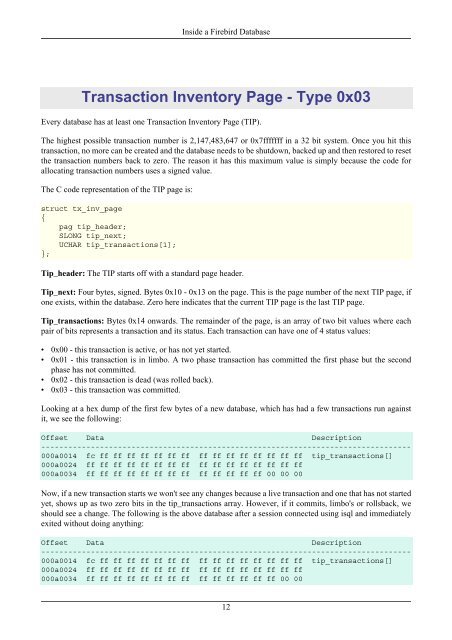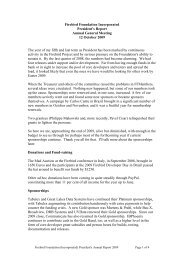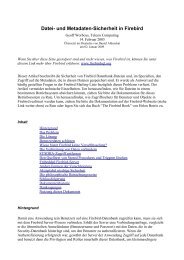Page Inventory Page - Type 0x02 - Firebird
Page Inventory Page - Type 0x02 - Firebird
Page Inventory Page - Type 0x02 - Firebird
You also want an ePaper? Increase the reach of your titles
YUMPU automatically turns print PDFs into web optimized ePapers that Google loves.
Inside a <strong>Firebird</strong> Database<br />
Transaction <strong>Inventory</strong> <strong>Page</strong> - <strong>Type</strong> 0x03<br />
Every database has at least one Transaction <strong>Inventory</strong> <strong>Page</strong> (TIP).<br />
The highest possible transaction number is 2,147,483,647 or 0x7fffffff in a 32 bit system. Once you hit this<br />
transaction, no more can be created and the database needs to be shutdown, backed up and then restored to reset<br />
the transaction numbers back to zero. The reason it has this maximum value is simply because the code for<br />
allocating transaction numbers uses a signed value.<br />
The C code representation of the TIP page is:<br />
struct tx_inv_page<br />
{<br />
pag tip_header;<br />
SLONG tip_next;<br />
UCHAR tip_transactions[1];<br />
};<br />
Tip_header: The TIP starts off with a standard page header.<br />
Tip_next: Four bytes, signed. Bytes 0x10 - 0x13 on the page. This is the page number of the next TIP page, if<br />
one exists, within the database. Zero here indicates that the current TIP page is the last TIP page.<br />
Tip_transactions: Bytes 0x14 onwards. The remainder of the page, is an array of two bit values where each<br />
pair of bits represents a transaction and its status. Each transaction can have one of 4 status values:<br />
• 0x00 - this transaction is active, or has not yet started.<br />
• 0x01 - this transaction is in limbo. A two phase transaction has committed the first phase but the second<br />
phase has not committed.<br />
• <strong>0x02</strong> - this transaction is dead (was rolled back).<br />
• 0x03 - this transaction was committed.<br />
Looking at a hex dump of the first few bytes of a new database, which has had a few transactions run against<br />
it, we see the following:<br />
Offset Data Description<br />
----------------------------------------------------------------------------------<br />
000a0014 fc ff ff ff ff ff ff ff ff ff ff ff ff ff ff ff tip_transactions[]<br />
000a0024 ff ff ff ff ff ff ff ff ff ff ff ff ff ff ff ff<br />
000a0034 ff ff ff ff ff ff ff ff ff ff ff ff ff 00 00 00<br />
Now, if a new transaction starts we won't see any changes because a live transaction and one that has not started<br />
yet, shows up as two zero bits in the tip_transactions array. However, if it commits, limbo's or rollsback, we<br />
should see a change. The following is the above database after a session connected using isql and immediately<br />
exited without doing anything:<br />
Offset Data Description<br />
----------------------------------------------------------------------------------<br />
000a0014 fc ff ff ff ff ff ff ff ff ff ff ff ff ff ff ff tip_transactions[]<br />
000a0024 ff ff ff ff ff ff ff ff ff ff ff ff ff ff ff ff<br />
000a0034 ff ff ff ff ff ff ff ff ff ff ff ff ff ff 00 00<br />
12
















